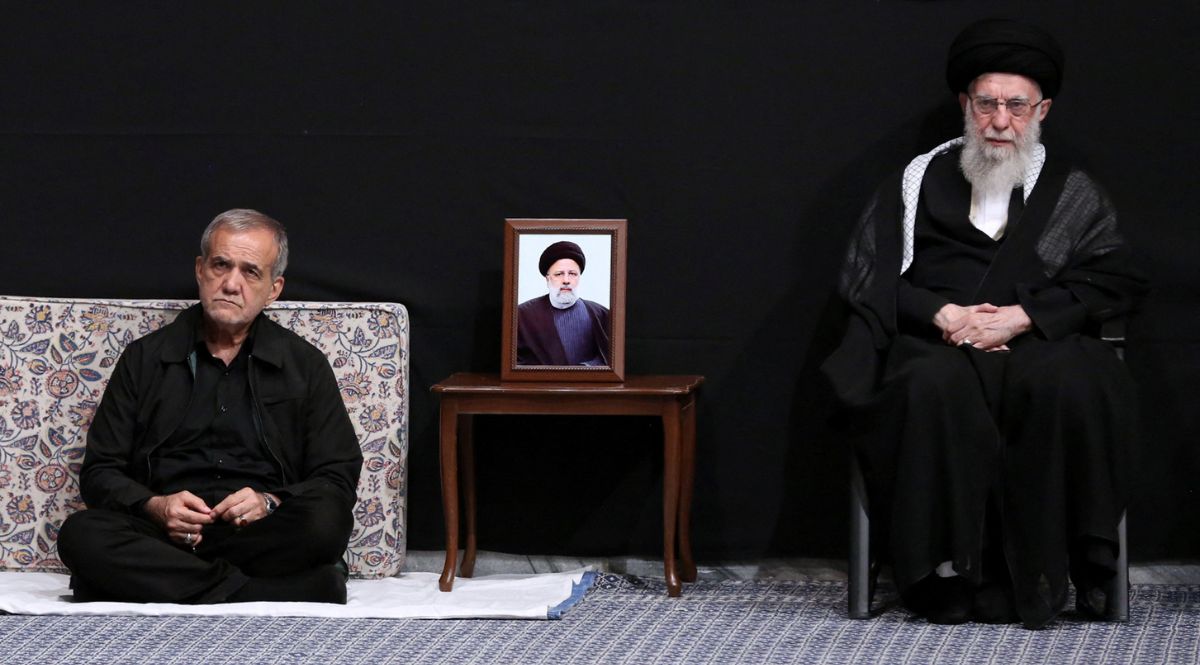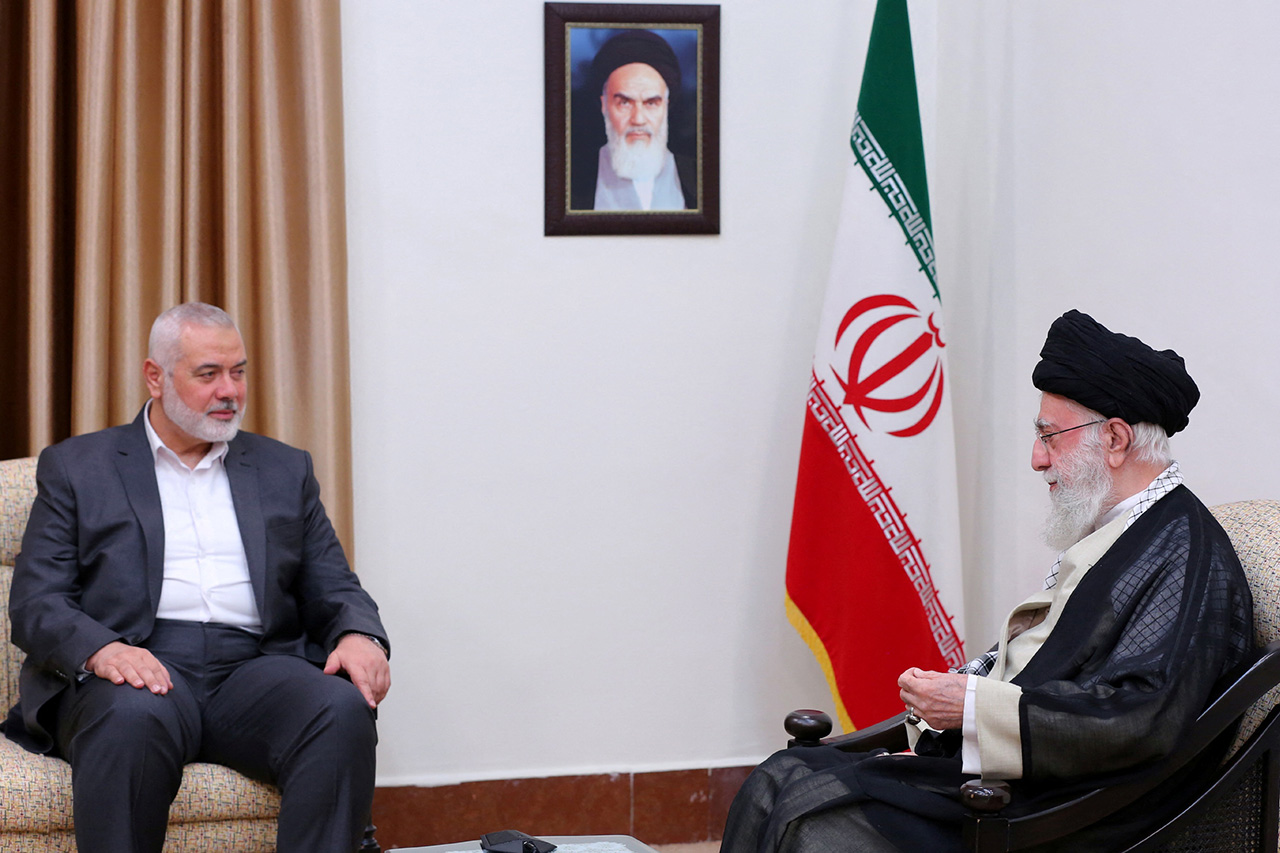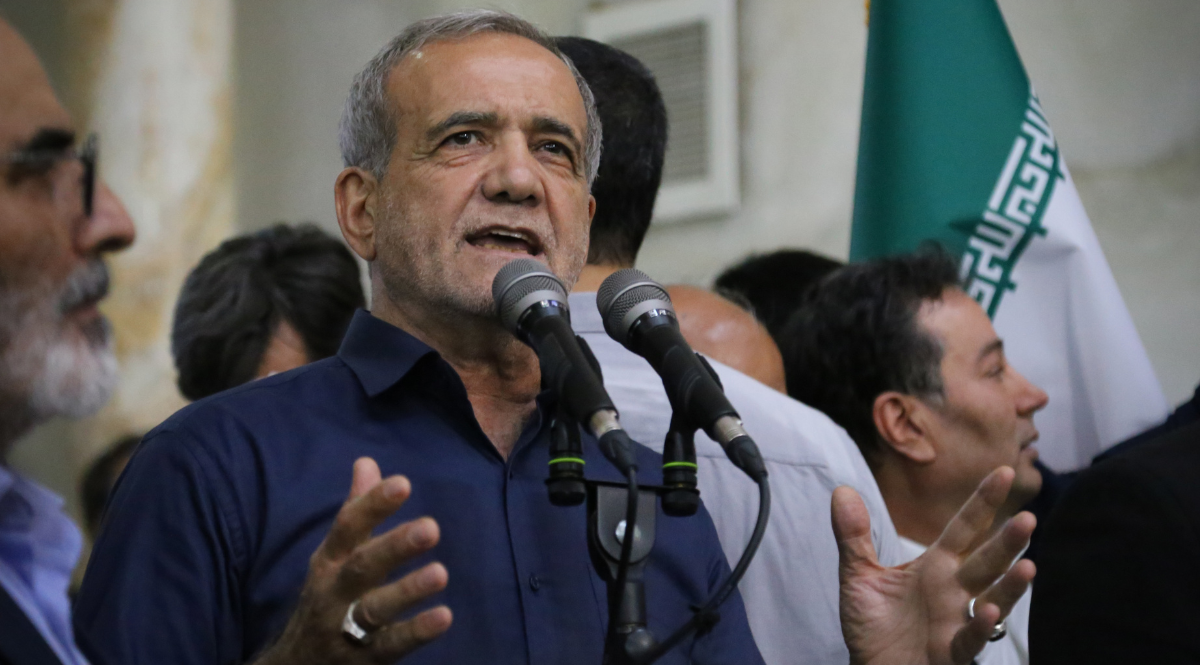Gauging the New President's Impact on Iran's Foreign Policy
The success of the reformist and secular Masoud Pezeshkian in the presidential elections may temporarily reduce international tensions around Iran. However, in practice Iran’s foreign policy will continue to be controlled by Supreme Leader Ali Khamenei and the Revolutionary Guards. Although Iran might change rhetoric and become more flexible on nuclear issues, the new president cannot significantly alter the basic course of the country’s post-revolutionary domestic and foreign policy.
 Office of the Iranian Supreme Le / Reuters / Forum
Office of the Iranian Supreme Le / Reuters / Forum
The early presidential elections after the death of Ebrahim Raisi were won by Masoud Pezeshkian, associated with factions of reformist and moderate conservatives, represented also by the former presidents Mohammad Khatami (1997-2005) and Hassan Rouhani (2013-2021). Mohamad Zarif is expected to return as foreign minister. He was the main Iranian negotiator of the JCPOA nuclear agreement (talks in 2013-2015).
President’s Role in Iranian Policy
According to the constitution of the Islamic Republic of Iran, the president is the second person in the state after Supreme Leader Ali Khamenei. The president is responsible for the implementation of domestic and foreign policy, including the activity of the cabinet of his ministers and day-to-day administration of the country. The parliament (Mejelis) approves his ministers and can dismiss the president with a two-thirds majority. The president also chairs meetings of the Supreme Council of National Security, whose composition is determined half by him and half by the Supreme Leader. Presidential initiatives are seriously limited or modified by Khamenei’s representatives in all ministries. The Supreme Leader ascended in 1989 and has lifetime tenure. The actual role of the Iranian president in the international arena is also a result of the confluence of numerous and informal interest groups of family and business connections within the Iranian elite. For example, the president of Iran must consider the influence of the Islamic Revolutionary Guard Corps (IRGC), whose position in internal, regional, and nuclear policies is not regulated by the constitution but remains visible and crucial.
The activities of Iran’s new government in the international arena will continue to adhere to the compromises between the Supreme Leader and presidential power centres, the discussions and decisions within the National Security Council, the influence and loyalty of the IRGC, and the views of the currently conservative Mejelis towards Khamenei. Pezeshkian and Zarif, with the approval of the Supreme Leader, will likely present a more pragmatic approach to any talks and contacts with the West compared to their predecessors and political rivals. The Ministry of Foreign Affairs, once again headed by Zarif, will determine the personnel, competences, and style of Iranian diplomacy. However, neither politician will have similar prerogatives in regional issues, which are responsibility of the Shia clergy and IRGC command.
Continuity of Iran’s Foreign Policy
Pezeshkian and Zarif declare their intention to end Iran’s international isolation and sanctions on it, as well as openness to relations with the EU. These are significant differences from both Raisi’s presidency and the other presidential candidates, with their slogans of no compromise. At the same time, the new government’s declarations lack detailed proposals or even outlines of necessary actions Iran might take to allow for a new opening towards Europe. Pezeshkian, in an op-ed on his foreign policy (Tehran Times, 12 July) stressed the continuation of Iran’s policy at the global and regional levels. Iran’s strategy for three decades has been focused on the development of informal alliances with China, Russia, and North Korea, and building a so-called Axis of Resistance with the Syrian regime, Shia militias, and radical Palestinian groups. The lack of significant Western economic investments in the JCPOA period also resulted in the Iranian elite’s calls for closer economic relations with Asian countries, especially China and India. However, détente in Iran’s relations with the EU (or even U.S.), as permitted by Khameni, will not limit bilateral alliances and cooperation with Russia or China. Pezeshkian confirmed his readiness to sign a new agreement negotiated by Raisi on a “comprehensive strategic partnership” with Russia.
The current regional context is also not particularly conducive to deeper changes in Iran’s Middle East policy. During the presidential campaign, Pezeshkian mentioned his service in the IRGC during the war with Iraq, and just after the elections he emphasised Iran’s unique alliance with the Lebanese Hezbollah. It seems that he might be interested in promoting some compromises with Saudi Arabia regarding the stabilisation of Yemen, Iraq, and Syria, but this higher level of cooperativeness and softer rhetoric towards rival Arab countries will not calm the whole region—an unrealistic scenario during the ongoing, intense Israeli ground operation in the Gaza Strip. Due to family ties between many of the Shia clerics in Iran, Lebanon, and Iraq, as well as the local interests of every Shia militia supported by Iran in the region, Zarif will not be in control of any other elements of regional policy. Moreover, the Iranian elite and IRGC commanders might also wrongly assume that they retain control of the escalation and tensions with Israel in Lebanon, Yemen and Gaza. Due to the global importance of the sea lanes between Asia and Europe via the Red Sea, Iran might be willing to limit or suspend Yemeni Houti missile strikes in this area. Such a solution might be perceived by Iran as an additional platform or bargaining chip in talks with Saudi Arabia and China, and perhaps with the EU and U.S., too.
Iran’s Flexibility on Nuclear Issues
An area in which more substantive change can be expected on Iran’s side is the nuclear dispute, which has been ongoing since the disclosure of its secret facilities in 2002. The JCPOA concluded in 2015 assumed limiting the scale of Iran’s nuclear programme and the level of uranium enrichment in exchange for the lifting of the most severe sanctions by the U.S., EU, and UN. As predicted, however, after Donald Trump terminated the JCPOA in 2018, Iran has been steadily increasing the amount and level of uranium enrichment, currently up to 60%. According to non-government estimates, Iran has enough various forms of enriched uranium to build 12-13 nuclear warheads within 3-4 months. Raisi’s government presented a rigid approach to returning to the JCPOA limits, for example demanding the deal’s ratification by the U.S. Congress and rejecting any annexes limiting its missile arsenal. Moreover, in 2020, the Mejelis adopted a law obliging the Iranian government to continue work on enriching uranium above the 20% level. At the same time, Iran is increasingly limiting the access of IAEA inspectors to its nuclear facilities, and in April-May this year, some IRGC commanders suggested the possibility of building a nuclear arsenal. It is worth noting that Saed Jalili, Pezeshkian’s rival for the presidency, as secretary of the National Security Council de facto obstructed nuclear talks in 2009-2013 and recently spoke in favour of Iran maintaining such actions and threats.
It seems that both Pezeshkian and Zarif have Khamenei’s approval to resume nuclear talks with the U.S. and EU. The Supreme Leader is the guarantor of compromise within the power elite on Iran’s status as a “threshold state”, in other words, a state capable of building a nuclear arsenal quickly in a crisis. The JCPOA in essence hampered these capabilities and extended the time it would take to do so to 9-12 months. However, Iran’s likely readiness to resume nuclear talks on some interim agreement or full return to JCPOA coincides now with the weakening of the Biden administration. It is unlikely that President Joe Biden will risk far-reaching concessions to Iran in the coming months. Such talks would quickly and easily become a campaign issue for Trump, known for his personal dislike of the JCPOA and Iran.
Conclusion
The new president of Iran is loyal to the Supreme Leader and has no ambition to clash with Khamenei on a policy course. Nevertheless, Pezeshkian’s presidency may temporarily relieve some tensions related to Iranian policies. His new government probably will avoid the uncompromising rhetoric in diplomacy characterised by the presidency of the late Raisi. Iran’s regional policy may be more realistic, although still controlled by the IRGC. The exception to greater pragmatism in the Middle East will be its ongoing rivalry with Israel, including the threat of escalation to war with Hezbollah. Just like during the presidencies of Khatami and Rouhani, Iran will likely attempt to exploit differences in the general approaches of the U.S. and EU towards the Islamic Republic. Moreover, the expected changes in Iran’s position on nuclear talks are now past the point of significant opportunities provided by the Biden administration’s previous flexibility. The scenario of a second Trump presidency does not increase the chances of maintaining any interim agreement or reviving the JCPOA after January 2025. Although there might be the usual voices from EU institutions and some of its Member States to return to the JCPOA, it will be very difficult for Europe to implement such policy independently or in conflict with the U.S. unilateral strategy and sanctions. Also, Iran’s growing deliveries of artillery ammunition, drones, and missiles to Russia for its war with Ukraine will remain an important issue for Poland and most of the EU and NATO countries. The unlikeness of separating the Iran-Russia informal alliance from other controversial issues in Iran’s internal and foreign policies will also make it difficult to normalise and develop EU-Iran relations, as suggested by Pezeshkian.





